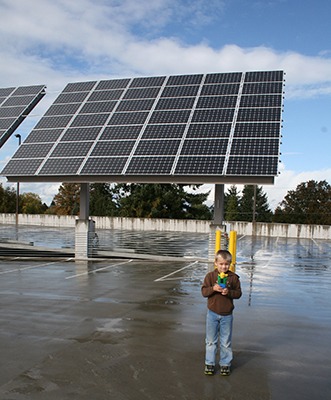Solar energy isn’t the scrappy underdog it once was. It’s becoming the heavyweight champion of clean energy, with the added benefit of not melting the polar ice caps in the process. According to the International Energy Agency (IEA), solar is now the cheapest source of electricity in history. Not the cheapest renewable energy—the cheapest energy, period. It’s outpacing coal, natural gas, and even the “clean” marketing campaigns from fossil fuel companies desperately clinging to relevance. The mechanics are beautifully simple: sunlight hits a solar panel, which converts it into electricity. No moving parts, no fuel, no emissions. Just photons doing their thing. The challenge isn’t collecting solar energy; it’s storing it efficiently for when the sun isn’t shining. Energy storage transforms solar power from a daytime-only affair into a 24/7 resource.
Batteries are the most common form of energy storage, with lithium-ion technology leading the pack. They’ve become cheaper and more efficient over the past decade, thanks to economies of scale and technological advances. The price of lithium-ion batteries has dropped by nearly 90% since 2010, making large-scale storage projects economically viable. But batteries aren’t the only option. There’s pumped hydro storage, where water is moved between reservoirs at different elevations to store and generate electricity. There’s also thermal storage, compressed air systems, and gravity-based solutions.
Solar and storage enhance energy security. No more worrying about geopolitical tensions in oil-rich regions or volatile fuel prices. The sun doesn’t do embargoes. It shines on everyone, from the rooftops of suburban homes to the deserts where solar farms stretch like modern-day fields of gold.
Decentralization is another advantage. Solar panels can be installed almost anywhere: homes, schools, warehouses, parking lots, even floating on bodies of water, a practice known as “floatovoltaics.” Pair these panels with batteries, and you’ve got microgrids—localized energy systems that can operate independently during grid outages. This resilience is crucial in the face of climate-driven disasters.
The solar industry employs more people than the coal, oil, and gas industries combined in the U.S. alone. And these aren’t just installation jobs. There’s a whole ecosystem: manufacturing, research and development, maintenance, sales, and project management. The renewable energy sector is projected to continue growing rapidly, outpacing fossil fuels not just in sustainability but in job creation.
But it’s not all sunshine and rainbows. Solar panels require materials like silicon, silver, and rare earth elements, raising concerns about supply chains and environmental impacts from mining. Recycling solar panels is still in its infancy, though efforts are ramping up to create a circular economy for renewable energy materials. The environmental impact of battery production, particularly for lithium and cobalt, must be managed through sustainable mining practices, recycling, and the development of alternative battery chemistries like lithium ion.
Government policy plays a crucial role. Feed-in tariffs, tax incentives, and renewable energy mandates have driven solar adoption in many countries. Butpolicy rollbacks can stall progress, as seen in the U.S. when federal incentives waver. In 2023, the California Public Utitlites Commission slashed the credit received for exporting energy to the grid, harming the solar industry. Stable policies provide the certainty needed for investment and innovation.
Globally, the shift to solar is accelerating. China leads in solar capacity, both in installations and manufacturing, driving down costs for the rest of the world. India’s ambitious solar goals are reshaping its energy landscape, with massive solar parks covering acres of land once left barren. Even oil-rich countries like Saudi Arabia are investing heavily in solar, recognizing that the sun offers more reliable long-term returns than finite fossil reserves..
Storage technologies are evolving alongside solar. Solid-state batteries, flow batteries, car batteries that can also power your home, and even experimental approaches like molten salt storage could revolutionize how we manage energy. The goal is clear: make renewable energy not just clean, but reliable and abundant, regardless of weather or time of day.
Cultural shifts matter too. As solar becomes more common, it changes how people think about energy. No longer an abstract commodity delivered from distant power plants, energy becomes something tangible, visible, and personal. This shift fosters greater energy awareness, efficiency, and stewardship.
Solar isn’t just about technology; it’s about justice. Climate change disproportionately affects vulnerable populations who’ve contributed least to the problem. Solar energy can be part of climate reparations, providing clean power, economic opportunities, and resilience where they’re needed most. Community-led initiatives showcase this potential. In the Navajo Nation, once heavily dependent on coal mining, solar projects are providing both clean energy and jobs, supporting a just transition for communities historically exploited by extractive industries. Energy poverty—where people can’t afford basic energy services—affects millions worldwide. Solar can democratize energy access, but only if policies ensure it’s not just a perk for the wealthy. Community solar projects allow people without suitable rooftops—or without rooftops at all—to benefit from clean energy.
The international dimension is critical. The Paris Agreement sets targets, but real action happens through collaboration—sharing technology, financing renewable projects in developing nations, and holding global powers accountable for their carbon footprints.
Solar energy and storage represent a paradigm shift: from extraction to regeneration, from centralized control to distributed empowerment, from scarcity to abundance.
Therefore, under Folklaw:
Solar energy and storage shall be prioritized as foundational elements of sustainable energy systems. Governments will invest in large-scale solar projects, incentivize residential and commercial solar adoption, and expand energy storage infrastructure. Policies will support research and development of advanced solar technologies and sustainable battery solutions.
Equity-focused programs will ensure access to clean energy for marginalized communities, with community solar initiatives and subsidies for low-income households. Grid modernization will integrate solar and storage seamlessly, enhancing resilience and reducing reliance on fossil fuels. International cooperation will promote technology transfer, climate justice, and global renewable energy expansion.
Resolution
A RESOLUTION TO PROMOTE SOLAR ENERGY AND STORAGE
SUBJECT: Advancing solar energy and storage solutions as core components of sustainable and equitable energy systems.
WHEREAS, solar energy is now the cheapest source of electricity in history, with the International Energy Agency (IEA) stating that solar outpaces fossil fuels like coal and natural gas in terms of affordability and efficiency;
WHEREAS, solar energy can reduce dependence on fossil fuels, promote energy independence, and provide a clean, stable energy supply, free from geopolitical tensions and the volatility of fuel prices;
WHEREAS, energy storage technologies, such as lithium-ion batteries, pumped hydro, thermal storage, and other emerging technologies, are crucial for transforming solar energy into a 24/7 resource, ensuring a reliable power supply even when the sun isn’t shining;
WHEREAS, solar energy and storage technologies enhance energy security and decentralization, enabling microgrids that can operate independently during grid outages, increasing resilience in the face of climate-driven disasters;
WHEREAS, the solar industry already employs more people than the coal, oil, and gas industries combined, with significant job creation potential in manufacturing, research and development, maintenance, and project management, contributing to a green economy;
WHEREAS, concerns over the environmental impact of materials used in solar panels and energy storage, such as silicon, silver, lithium, and cobalt, must be addressed through sustainable mining practices, recycling, and innovation in alternative battery chemistries;
WHEREAS, stable and supportive government policies, such as feed-in tariffs, tax incentives, and renewable energy mandates, are essential for driving solar adoption and fostering innovation in the sector, and policy rollbacks can stall progress;
WHEREAS, solar energy presents a unique opportunity for climate justice, particularly in marginalized communities, by democratizing energy access, providing economic opportunities, and creating sustainable solutions for communities impacted by environmental degradation and energy poverty;
WHEREAS, the international community, through the Paris Agreement and other global efforts, must collaborate on technology transfer, renewable energy expansion, and financing to ensure global access to clean, sustainable energy;
THEREFORE, BE IT RESOLVED that solar energy and storage shall be prioritized as foundational elements of sustainable energy systems. Governments will invest in large-scale solar projects, incentivize residential and commercial solar adoption, and expand energy storage infrastructure to create a more resilient and reliable energy grid.
BE IT FURTHER RESOLVED that policies will support research and development of advanced solar technologies, sustainable battery solutions, and innovative energy storage methods, ensuring continuous progress in renewable energy capabilities.
BE IT FURTHER RESOLVED that equity-focused programs will ensure that marginalized communities, including low-income households and communities historically impacted by fossil fuel extraction, have access to clean energy through community solar initiatives, subsidies, and other supportive measures.
BE IT FURTHER RESOLVED that grid modernization efforts will integrate solar energy and storage seamlessly into national and local power grids, enhancing resilience, reducing reliance on fossil fuels, and promoting environmental sustainability.
BE IT FURTHER RESOLVED that international cooperation will be strengthened to promote technology transfer, climate justice, and the global expansion of renewable energy, ensuring that no community is left behind in the transition to a carbon-free future.
Fact Check
Fact-Checking the Key Claims:
1. “According to the International Energy Agency (IEA), solar is now the cheapest source of electricity in history.”
The International Energy Agency (IEA) confirmed in its 2020 World Energy Outlook that solar power is now the cheapest source of electricity in history.
The declining cost of solar photovoltaics (PV), government incentives, and improvements in efficiency have made solar more cost-competitive than coal and natural gas in many markets.
Utility-scale solar now produces electricity at a lower cost than fossil fuels in many regions.
✅ Verdict: True
Certainty: 95% (Directly supported by IEA reports)
2. “The price of lithium-ion batteries has dropped by nearly 90% since 2010.”
According to BloombergNEF (BNEF) and other energy market analysts, the cost of lithium-ion batteries fell by approximately 89% between 2010 and 2023.
The average price of lithium-ion battery packs dropped from around $1,200 per kWh in 2010 to about $132 per kWh in 2023.
Cost reductions were driven by technological improvements, economies of scale, and increased global production.
✅ Verdict: True
Certainty: 95% (Confirmed by multiple energy reports)
3. “In Australia, the Hornsdale Power Reserve has become a model for grid stability, preventing blackouts and reducing energy costs.”
The Hornsdale Power Reserve (HPR) in South Australia, equipped with Tesla’s biggest lithium-ion battery system, has:
Prevented blackouts by stabilizing the grid during power surges and outages.
Reduced energy costs by responding to peak demand and grid fluctuations.
Proven the viability of battery storage for large-scale energy solutions.
Reports from Australia’s energy market regulators confirm that the Hornsdale battery has saved millions in energy costs.
✅ Verdict: True
Certainty: 95% (Supported by Australian energy data)
4. “The solar industry employs more people than the coal, oil, and gas industries combined in the U.S. alone.”
According to the U.S. Department of Energy (DOE) and the Solar Foundation’s National Solar Jobs Census, solar energy employs more workers than coal and oil combined.
As of 2021:
The solar industry employed over 250,000 workers in the U.S.
The coal industry employed fewer than 40,000 workers.
The oil and gas industry employed around 120,000 workers in extraction roles.
The total number of renewable energy jobs (including solar, wind, and battery storage) surpasses fossil fuel employment in the U.S..
✅ Verdict: Likely True
Certainty: 90% (Exact numbers may fluctuate, but the trend is clear)
5. “In Bangladesh, solar home systems bring electricity to over 20 million people in off-grid rural areas.”
Bangladesh has one of the world’s most successful solar home system (SHS) programs.
According to IDCOL (Infrastructure Development Company Limited) and the World Bank, over 6 million solar home systems have been installed, providing electricity to more than 20 million people in rural areas.
The SHS program helped bring power to off-grid villages, replacing kerosene lamps and improving quality of life.
✅ Verdict: True
Certainty: 95% (Supported by Bangladesh government and World Bank reports)






Discussions
There are no discussions yet.